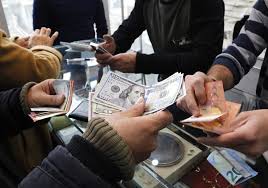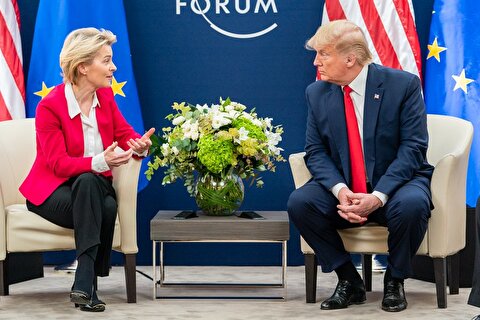
Iran Dollar Ban for Imports in Line With Currency Policy

The directive, announced unexpectedly by the Ministry of Industries, Mining and Trade on Wednesday, states that import orders by merchants based on US currency would no longer be allowed to go through.
The ban was predictable, considering Iran's efforts to ditch the US dollar in its international dealings in response to US primary sanctions that bans dollar transactions by Iranian nationals.
Iran had for long complained that the benefits of the nuclear deal it signed with world powers, including Washington, in 2015 failed to deliver the economic windfall promised to Iran, prompting the Governor of the Central Bank of Iran Valiollah Seif to refer to those gains as "almost nothing".
An update by the US Treasury Department’s Office of Foreign Assets Control in 2016 clarified that banks can engage in US dollar-denominated transactions involving Iran or Iranian parties as long as those transactions do not pass through the United States or otherwise involve a US person–an announcement that almost did nothing to remove confusion.
In the post-deal era, Iran responded with a slew of measures to counter dollar restrictions, including clinching agreements with several nations to use the national currencies.
In October, the central banks of Turkey and Iran allocated a credit line of 5 billion lira ($1.4 billion) and its equivalent in rial to their respective agent banks to be used as letters of credit with a repayment period of one year for both countries' traders.
In a meeting with Russian President Vladimir Putin in November, Iran's Leader Ayatollah Seyyed Ali Khamenei proposed that in order to beat US sanctions, the two countries should launch efforts to dump the American currency in bilateral trade. He told President Putin that by using methods such as eliminating the US dollar and replacing it with national currencies in transactions between two or more parties, they could sideline the greenback.
According to CBI's Head of Exports Department Samad Karimi, Iran currently has a total of 10 "memoranda of understanding and protocols" pertaining to monetary agreements with other countries.
Serving Multiple Goals
The new ban, therefore, is officially executing the long overdue plan Iranian traders were already expecting.
Since Iranian banks could not process dollar transactions, the duty fell to exchange shops. But the dominant role enjoyed by currency-trading offices ran contrary to CBI's plans to bring banks at the center of forex trading and thereby end years of murky trade practices prevalent during the sanctions.
In December 2016, CBI authorized banks to deal in foreign exchange trading at a free market rate as part of its moves to unify the exchange rates.
Mehdi Kasraeipour, the central bank’s director for foreign exchange rules and policies, told IRNA on Friday that since the share of US dollar in Iranian trading is not high, this won't cause any business disruption.
He noted that importers can choose alternative currencies instead of dollars to price their imports.
According to data by the Islamic Republic of Iran Customs Administration, in the fiscal 2016-17, out of the $42.7 billion of imports, more than 60% came from China, India, the EU and the UK. The share of imports from the US accounted for a mere 1% during this period.
Iran had indicated in the past that it intends to conduct most of its foreign exchange transactions in euro. The latest move has also been interpreted as a step toward embracing the European currency.
The letter by CBI chief to Mohammad Shariatmadari, the industries minister, which is believed to have prompted the ban–also showed that Seif had lower demand for dollar and a bigger forex role for banks in mind when he first pitched the idea.
Pouya Jabal Ameli, an economist, told Financial Tribune that the ban was the latest move by CBI to "limit its interventions in the forex market to euro."
"The ultimate goal is for CBI to intervene in the market through euro and render itself free of the US dollar," he said.
Having declined in value against the dollar through much of 2017, the rial lost a further 8% in January alone, as judged by the market rate.
Mohammad Lahouti, the head of Iran Exports Federation and a business figure, traced the move to pressures by the US and moves to curb demand for the US dollar in the forex market.
Lahouti, however, told IBENA that the move would likely increase the cost of trade for Iranian merchants since there will be extra currency swapping in order to comply with the CBI ban.


Gold price eases after Trump downplays clash with Fed chair Powell

Copper price hits new record as tariff deadline looms

Brazil producers look to halt pig iron output as US tariff threat crimps demand

Three workers rescued after 60 hours trapped in Canada mine

Gold price could hit $4,000 by year-end, says Fidelity

US targets mine waste to boost local critical minerals supply

Energy Fuels surges to 3-year high as it begins heavy rare earth production

Glencore workers brace for layoffs on looming Mount Isa shutdown

Chile’s 2025 vote puts mining sector’s future on the line

Kinross divests entire 12% stake in Yukon-focused White Gold

Gold price could hit $4,000 by year-end, says Fidelity

Southern Copper expects turmoil from US-China trade war to hit copper

Ramaco Resources secures five year permit for Brook rare earth mine in Wyoming

Column: EU’s pledge for $250 billion of US energy imports is delusional

Finland reclaims mining crown as Canada loses ground

Gold price down 1% on strong US economic data

Trump’s deep-sea mining push defies treaties, stirs alarm

Chile’s 2025 vote puts mining sector’s future on the line

Gold price retreats to near 3-week low on US-EU trade deal

Gold price could hit $4,000 by year-end, says Fidelity

Southern Copper expects turmoil from US-China trade war to hit copper

Ramaco Resources secures five year permit for Brook rare earth mine in Wyoming

Column: EU’s pledge for $250 billion of US energy imports is delusional

Gold price down 1% on strong US economic data

Trump’s deep-sea mining push defies treaties, stirs alarm

Chile’s 2025 vote puts mining sector’s future on the line

Gold price retreats to near 3-week low on US-EU trade deal

China’s lithium markets gripped by possible supply disruptions














